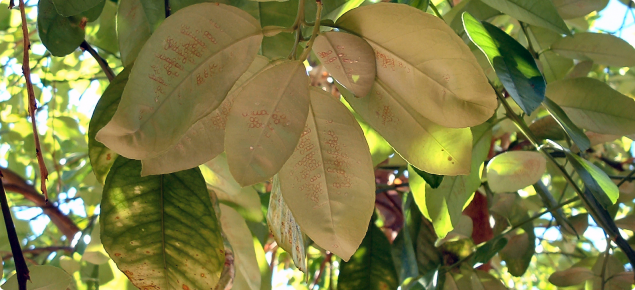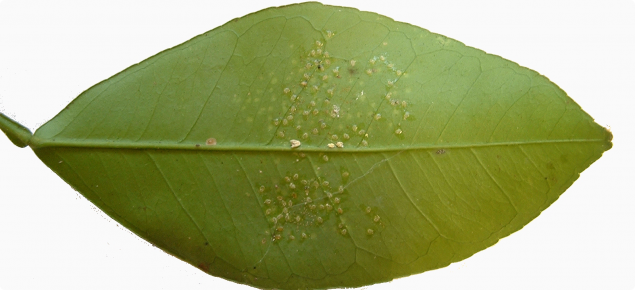Damage
- Whiteflies have a piercing-sucking mouthpart that they insert into the plant tissue to feed on leaves. Leaves may wilt and drop as a result of feeding damage if populations are high.
- Large quantities of a sweet sugary material known as honeydew are also secreted by the whiteflies. Leaves and fruit often turn black with the growth of sooty mould fungus on the honey dew.
- Lemon trees are the favourite host, but all types of citrus are vulnerable to attack.
- Whiteflies are not usually a problem of citrus in Australia.
 Life cycle
Life cycle
- Oval-shaped eggs are laid on the underside of mature young leaves in horseshoe shaped or circular patterns. The eggs often appear as if they have been dusted with white powdery wax. From these the larvae or ‘crawlers’ emerge.
- The larvae settle in groups on the underside of the leaf and look like small scales. After a few weeks the outer coverings of the larvae harden and form pupal cases. From the pupae, the adults later emerge to continue the lifecycle.
- There are several generations of whitefly a year. The greatest populations usually occur in spring and autumn, coinciding with growth flushes. All growth stages can often be found on citrus trees at any one time.
Identification
- Adult Orchamoplatus citrus is about 2.5mm long. Both pairs of wings and the body are covered with a white, waxy, wool-like secretion. The adults cluster on young shoots and leaves. Adults will fly off in clouds when disturbed.
- Another indication of whitefly infestation is the presence of eggs laid in circular patterns and other immature stages sticking to the undersides of the leaves.
Control
- Horticultural oil sprays help control whitefly. In most cases, however, action is rarely required.
- Always check the label before spraying, as not all oils are registered for use in citrus.
 Biological control
Biological control
- Parasites of whiteflies include wasps such as Encarsia sp.
- Several predatory insects have been found associated with whitefly. These include small beetles belonging to the family Nitidulidae. The beetle larvae have been observed destroying the whitefly eggs and using the empty shells to decorate their light pupal covering.
- Naturally occurring beneficial insects include ladybirds, lacewing and syrphid (hoverfly).
Further reading
Citrus pests and their natural enemies: integrated pest management in Australia, by D Smith, GA Beattie & RH Broadley (eds), Queensland Department of Primary Industries, 1997.



